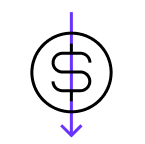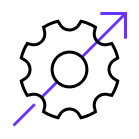CockroachDB vs Oracle
Distributed SQL has become the go-to choice for modern applications, offering the scalability, resilience, and performance needed in today’s global landscape. However, not all distributed SQL databases are created equal.
In this comparison, we look at CockroachDB alongside Oracle GDD, a complex and expensive database designed to mimic distributed SQL functionality, but one that falls short of CockroachDB's native resilience, consistency, and global data distribution.
Why leading enterprises choose CockroachDB

Lower cost of ownership
Say goodbye to costly upcharges and add-ons. CockroachDB can reduce application and ops overhead by up to 90% through automation.

Simplified operations
CockroachDB offers native scaling without manual sharding, freeing up engineering hours for more productive tasks. And, no-downtime schema updates and software upgrades means less planned application downtime.
Cloud flexibility
Stay agile and avoid vendor lock-in. Run CockroachDB on AWS, Azure, or GCP, in your own data center, or in a hybrid configuration.
Side-by-side comparison



Shared-nothing logical database.
Single logical database cluster.
One binary to deploy, reducing risk with a simplified application stack.
A logical representation of multiple independent physical databases. Each physical database is a “shard”.
Requires separate sharding control plane layer for transaction management and query processing whenever >1 shards are used.
Requires multiple add-on Oracle products (binaries) and increased expertise to achieve a distributed database solution.
Uses multitenant architecture where a single container database (CDB) can host many ‘pluggable’ database instances (PDBs). These tenant PDBs may be for one or multiple separate customers all on the same Oracle instance.
Not capable of performing distributed transactions.
Scale horizontally by adding additional nodes
Automatic load balancing instantly and intelligently redistributes data between existing and new nodes
Multi-active (active-active-active) availability with at least 3 active nodes to distribute data and perform writes.
Database can scale beyond single machines by letting all nodes in a cluster serve reads and writes
Built-in high availability and fault tolerance; set availability goals at the database, table, or row level
High availability on single cloud, multi-cloud, self-hosted, or hybrid deployments
High availability best achieved using expensive add-ons such as Oracle RAC, many of which only run in OCI
Requires configuring and maintaining a dedicated “Fast Recovery Area” on a separate disk group
Oracle GDD offers traditional active-active availability built in
A limited version of multi-active availability is achievable if adding Oracle Golden Gate and Active Data Guard services and running on OCI
High availability achievable only with additional Oracle services (Exadata, Data Guard, Active Data Guard)
Oracle GDD SLA: 99.95% uptime (with Oracle Globally Distributed Autonomous Database serverless implementation on OCI)
Guaranteed Serializable isolation by default
Offers read committed
Only within single shards/instances.
ACID transactions not available when data required for that transaction is split onto on multiple shards/instances
Zero downtime maintenance is built in
CockroachDB allows online schema changes and rolling upgrades
Downtime is required for updates
Availability can be improved by adding on additional Oracle services at additional cost (RAC, Exadata, Data Guard, Oracle Fleet Patching & Provisioning, etc)
Schema changes are theoretically possible with highly manual application multi-versioning *
Downtime is required for updates
Availability can be improved by adding on additional Oracle services at additional cost (RAC, Exadata, Data Guard, Oracle Fleet Patching & Provisioning, etc)
While schema changes appear to be online, the operations still require user intervention and are not 100% autonomous
*For example, version 1 of your app supports schema A, and you want to introduce schema B. First you release app version 2 that is able to work with both schemas A and B. Then with version 3 you update the schema to B. Last you deprecate support for schema A in version 4. This is one of the reasons NoSQL was invented.
Comparative claims based on publicly available information as of September 2025.
Architected for mission-critical transactional use cases
Relational databases are founded in relational algebra and deliver a highly efficient store that enforces data integrity in the database as opposed to in code.
Life beyond Oracle starts here
Schedule time with our team to discuss your business goals and how CockroachDB can help.

Comparative claims based on publicly available information as of September 2025.




